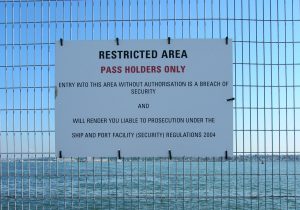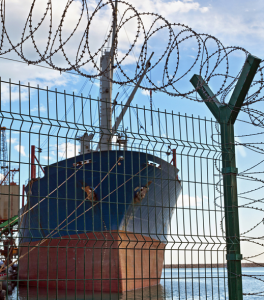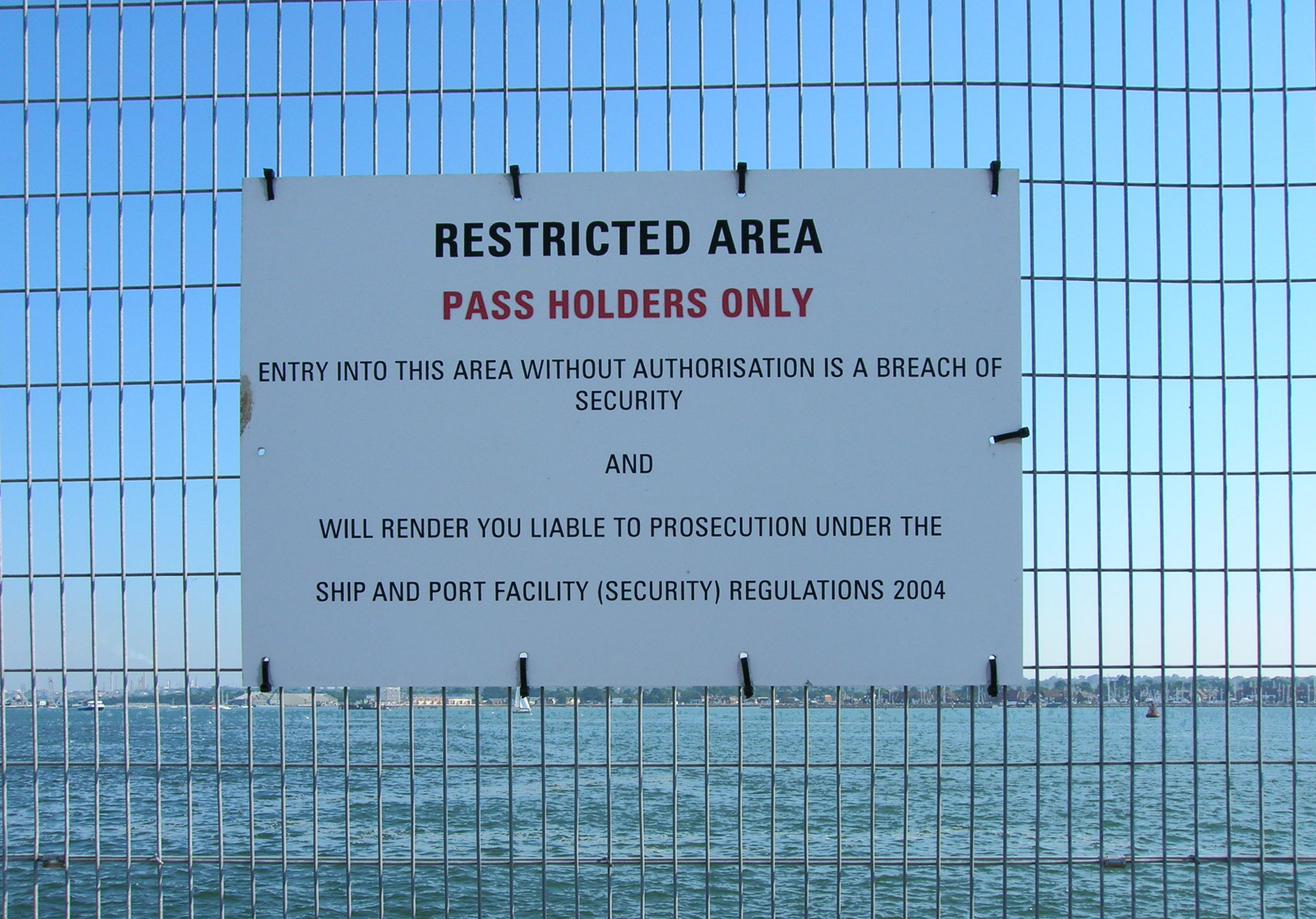ISPS Code
The International Ship and Port Facility Security (ISPS) Code is a set of regulations developed by the International Maritime Organization (IMO) in 2002 in response to concerns about potential terrorist attacks on ships and port facilities. The purpose of the code is to establish a framework for assessing security risks, determining appropriate security measures, and ensuring compliance with those measures to enhance the security of ships and port facilities.
The ISPS Code applies to all ships engaged in international voyages and to all port facilities used by such ships. The code requires that all ships and port facilities develop and implement security plans that identify security risks and appropriate security measures to address those risks. The security plans must be approved by the relevant national authorities and must be reviewed and updated regularly. The ISPS Code sets out specific security measures that must be implemented, including access control measures such as fencing, surveillance systems, and security patrols; screening measures for people, baggage, cargo, and vehicles; and security training for personnel. The code also requires that ships and port facilities establish communication protocols for reporting security incidents and responding to security threats.
ISPS Code Regulations for Ports

Port-side regulations under the ISPS Code focuses on ensuring that port facilities are secure and that ships are able to enter and exit the port in a safe and secure manner. Port facilities are required to develop security plans that identify security risks and appropriate security measures to address those risks. The security plans must be approved by the relevant national authorities and must be reviewed and updated regularly. Port facilities must also establish access control measures to restrict access to the facility to authorized personnel only. This may include fencing, security personnel, and identification systems. Port facilities must also establish screening measures for people, baggage, cargo, and vehicles entering the facility. In addition to these measures, the ISPS Code requires that ships and port facilities establish communication protocols for reporting security incidents and responding to security threats. This includes reporting any security incidents or suspicious activities to the relevant national authorities.
While the ISPS Code is an important tool for enhancing the security of ships and port facilities, it has also had some negative impacts on port communities. The installation of physical barriers and other security measures has restricted access to the marina and waterfront areas, leading to concerns about the impact on the cultural and social fabric of these communities. The use of barbed wire and other fencing materials has also been a point of contention, with many arguing that these measures create an unwelcoming and hostile environment for visitors and residents alike. Port side regulation under the ISPS Code focuses on ensuring that port facilities are secure and that ships are able to enter and exit the port in a safe and secure manner. While the ISPS Code is an important tool for enhancing the security of ships and port facilities, it is essential to strike a balance between security and the preservation of the cultural and social fabric of port communities.
The ISPS Code outlines several regulations for ports to ensure the security of ships and port facilities. These regulations include:
- Port Facility Security Assessment (PFSA): The purpose of PFSA is to identify potential security threats and vulnerabilities in the port facility. The assessment considers a wide range of factors, such as the location and design of the facility, the nature of the cargo and vessels, and the surrounding environment. The assessment helps in developing an effective security plan to mitigate the risks and threats identified.
- Port Facility Security Plan (PFSP): This is a comprehensive document that outlines the security measures that the port facility will take to address the security threats and vulnerabilities identified in the PFSA. The plan specifies the roles and responsibilities of different personnel, the procedures for handling security incidents, and the communication channels for reporting security incidents. The PFSP is reviewed and updated regularly to ensure that it remains relevant and effective.
- Access Control: The ISPS Code requires the implementation of access control measures to prevent unauthorized access to the port facility. The access control measures may include the use of identification cards, background checks for personnel, and the use of surveillance cameras to monitor access points. Only authorized personnel and vehicles should be allowed access to the port facility.
- Security Training and Awareness: The ISPS Code requires that port personnel receive security training and are made aware of the security measures and procedures in place. The training should cover the identification of potential security threats, the proper handling of suspicious packages or activities, and the procedures for reporting security incidents. The personnel should also be aware of their roles and responsibilities in maintaining the security of the port facility.
- Security Equipment: The ISPS Code requires the installation and maintenance of security equipment, such as surveillance cameras, alarms, and access control systems. The equipment should be capable of detecting and responding to security threats, and the personnel should be trained to use the equipment effectively. The maintenance of the equipment should be regularly carried out to ensure that it remains in good working condition.
- Regular Security Drills and Exercises: The ISPS Code requires that regular security drills and exercises be conducted to test the effectiveness of the security measures and to ensure that personnel are prepared to respond to security threats. The drills and exercises should simulate different scenarios, such as bomb threats or hijacking attempts, and should involve all relevant personnel. The results of the drills and exercises should be evaluated and used to improve the effectiveness of the security measures.
Overall, the ISPS Code aims to improve the security of ports and ensure that they are better prepared to prevent, deter, and respond to security threats.
Balancing Security and Community Access: The Impact of ISPS Code on Waterfront of Port Cities

However, these security measures have also had a negative impact on the communities living in and around port cities. The installation of fences and other physical barriers has restricted the access of local residents to the marina and water front, leading to concerns about the impact on the cultural and social fabric of these communities. The communities feel that their freedom to access these public spaces has been restricted, and that they are being excluded from an important aspect of their local identity and heritage.
The use of barbed wire and other fencing materials has also been a point of contention, with many arguing that these measures create an unwelcoming and hostile environment for visitors and residents alike. The aesthetics of the marina and waterfront have also been affected, with some arguing that the fencing and other security measures detract from the natural beauty of these areas. The restrictions on access to the marina and water front have also had economic consequences, with some arguing that they have deterred visitors and tourists from visiting port cities and ports. This has had a negative impact on local businesses that rely on tourism and recreation, further exacerbating the economic challenges faced by these communities.
The challenges in implementing the ISPS Code in port cities are related to balancing the need for security with the rights of the local community. The ISPS Code requires that physical barriers and other security measures be put in place to protect port facilities and ships from security threats. However, the installation of these measures can create a negative impact on the surrounding community, as discussed earlier.
Regarding the rights of port city people to access waterfronts, it can be argued that the ISPS Code does limit their access to public spaces, such as marinas and waterfronts, by implementing physical barriers. The local community may feel excluded and that their freedom to access these areas has been restricted. This issue can be further exacerbated in cases where access restrictions are not clearly communicated to the public or where there are limited alternative routes for people to access the waterfront. Therefore, it is important to balance the security needs with the rights of the local community to access public spaces. This requires effective communication and engagement with the local community during the implementation of security measures. It also highlights the importance of considering the broader impact of security measures on the economic, cultural, and social fabric of port cities and their surrounding communities.
Despite these concerns, it is important to note that security remains a critical priority for the maritime industry and the communities that rely on it. The challenge is to balance the need for enhanced security with the preservation of the cultural and social fabric of port cities and ports. In this context, there is an opportunity to explore innovative approaches to security that are more sensitive to the needs and values of local communities. Moving forward, the future importance of urban-maritime cultures and communities within a global context will depend on our ability to strike this balance. The challenges facing port cities and ports are not unique, and similar issues are likely to arise in other parts of the world as the maritime industry continues to grow and evolve. As such, it is essential that we work together to find solutions that enhance security while preserving the unique cultural and social fabric of these communities.
Author: Dr.Reza Karimpour

